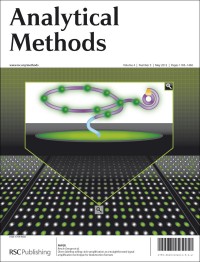Take a look at the latest issue of Analytical Methods, complete with two striking covers (if we do say so ourselves).
The front cover highlights work from Ute Resch-Genger of BAM Federal Institute for Materials Research and Testing, Berlin and his collaborators from across Germany. They have established an improved signal amplification protocol for biological assays using rolling circle amplification RCA, direct enzymatic labeling and the potential Cy3-substitute DY-555. The authors say their straightforward detection protocol can be applied to many other assay formats using a DNA primer to improve their detection limits, such as immunoassays, and that the strategy could be attractive for point-of-care diagnostics.
Direct labeling rolling circle amplification as a straightforward signal amplification technique for biodetection formats
Lena Linck, Edda Reiß, Frank Bier and Ute Resch-Genger
Anal. Methods, 2012, 4, 1215-1220
DOI: 10.1039/C2AY05760C
Featured on the inside front cover is a communication from Erqun Song, Yang Song and their colleagues from Southwest University, Chongqing, China. They report the one-step synthesis of N-acetylglucosamine-functionalized gold nanoparticle (NAG–AuNP), which then served as a facile, economic, highly sensitive and selective sensor for the detection of lectin from wheat germ, based on colorimetric and resonance light scattering signals. The authors expect that their new nanoparticles could be adapted for many applications in the future.
Communication: One-step facile synthesis of N-acetylglucosamine-functionalized gold nanoparticles for direct visual and light-scattering detection of lectin from wheat germ
Erqun Song, Jingrong Li, Hong Wei and Yang Song
Anal. Methods, 2012, 4, 1199-1201
DOI: 10.1039/C2AY25209K
These cover articles will be free to access for 6 weeks, and don’t forget to take a look at the HOT papers in this issue too.












